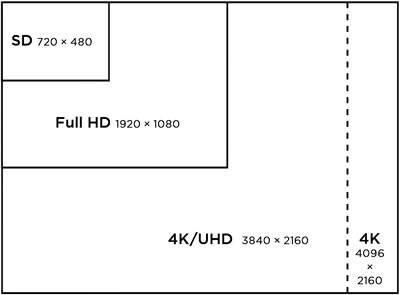4K resolution falls under Ultra High Definition (UHD), a term that encompasses better resolution, color, and frame rates than HD. 4K resolution describes display devices or content having horizontal resolution on the order of 4,000 pixels. More specifically, 4K resolution can be broken down into True 4K and 4K UHD. True 4K (4K x 2K) has a resolution of 4,096 x 2,160 pixels. 4K UHD must have a minimum resolution of 3,840 pixels wide and 2,160 pixels high, making a 4K UHD screen the equivalent of two 1080p screens in height and two in length.
Several 4K resolutions exist in the fields of digital television and digital cinematography. In the movie projection industry, Digital Cinema Initiatives (DCI) is the dominant 4K standard. Video support may vary based on host device, file attributes, and other factors. 4K UHD is more commonly being used in a home context for their TV screens and is also becoming the standard for many premium smartphones and cameras. On the other hand, True 4K is often used by some projectors and many professional cameras. Plus, there are SD cards for 4K video to consider.
With the arrival of 4K, there are four main resolution standards for use in the home: standard definition (480p/540p), high definition (720p), full high definition (1080p) and ultra-high definition (2160p).











